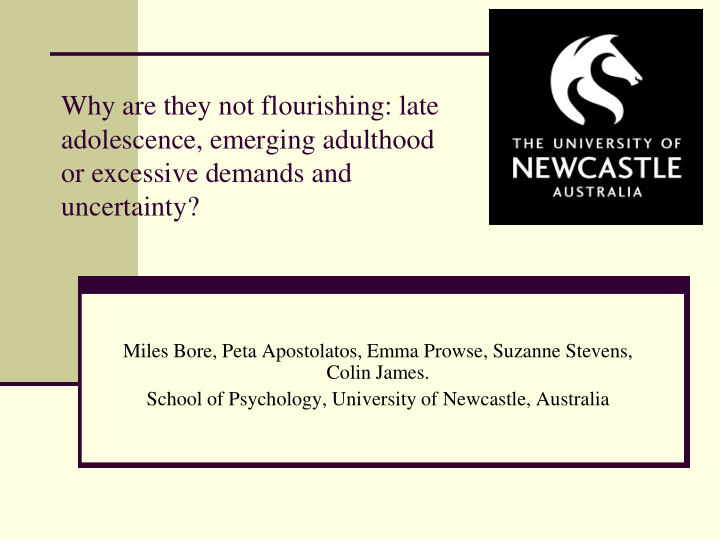



Why are they not flourishing: late adolescence, emerging adulthood or excessive demands and uncertainty? Miles Bore, Peta Apostolatos, Emma Prowse, Suzanne Stevens, Colin James. School of Psychology, University of Newcastle, Australia
Flourishing? Our students Majority are18 to 25 year olds Educated Through the adolescence stage Greater freedom and choice (?) Peak of physical fitness (although development still occurring) Relatively strong social support
Levels of psychological distress Brief Symptom Inventory Derogatis L. R. (1975, 2004) Instructions How much has each problem bothered you in the last 7 days 53 items, e.g, Pains in heart or chest Thoughts of ending your life Feeling lonely Difficulty making decisions 5 point scale 0 not at all ……..4 Extremely
BSI Scores Global Severity Index (GSI) Responses summed and dived by 53 GSI score range 0 to 5 Nine symptoms cluster scores Obsessive-Compulsive Interpersonal Sensitivity Anxiety Depression Hostility Paranoid Ideation Psychoticism Somatization Phobic Anxiety
Combined Samples Males Females Median Age Medical 156 244 20 students Psychology 92 356 19 students Law students 145 190 20 Total 393 790
Global Severity Index 140 120 100 Frequency 80 60 40 20 0 0.0 0.5 1.0 1.5 2.0 2.5 3.0 3.5 GSI
With norms Sample mean = .81 Diff to: Adult NP p < .000 Adol NP ns Adult PI p < .000 Adult PO p < .000
GSI by Discipline 4 Proportion > than Adult IP norm: 3 Med 19% Psyc 27% Law 22% 2 GSI Adult OP Psyc higher Adult IP 1 than Med p Adol NP < .05 Adult NP Law ns Med 0 or Psyc Med Psych Law Discipline
Reliability and Validity Alpha = .96 Correlates strongly with Females score higher K10 r = .63 than males .75 vs .84, p GHQ12 r = .61 = .02 SWB r = -.52 Sat W Life r = -.48 Correlates strongly with EQ r = -.38 Big 5 Neuroticism r = .58
Factor Analysis Extracted two factors, Oblimin rotation: Depression factor and Anxiety factor, r = .68
Two factors 0.3 0.2 0.1 Data 0.0 -0.1 -0.2 -0.3 Discipline Med Psych Law Med Psych Law F1Depression F2Anxiety Factor mean scores by group with 95% CIs
Symptom Dimensions 1.6 Students Adult norm 1.4 Adoles norm Adult IP norm 1.2 1.0 Data 0.8 0.6 0.4 0.2 0.0 D n d y y c a x s e t s t i m n C i t e i o e l o A S O i n i o r t x h b t p s a n n S c o o e r I A y h H a D s P P P
Symptom Dimensions by Group Discipline 1.50 Med Psych Law 1.25 1.00 Data 0.75 0.50 OCD IntSen Anxiety Hostility Paranoid Soma PhobAnx Depress Psychotic
Top 5 rated items
Item with greatest differential: ‘Getting into frequent arguments’ Main effect of 1.2 Discipline significant: 1.0 Getting into frequent arguments F = 10.3, p <.001 0.8 0.6 Law ‘getting into frequent 0.4 arguments’ significantly more 0.2 than Med or Psyc 0.0 Gender Male Female Male Female Male Female Discipline Med Psyc Law
Symposium Summary A significant proportion of students report high levels of General psychological distress K10, GHQ, GSI OC anxiety symptoms Personality disorder symptoms Eating disorder symptoms BSI profile looks more like adolescent (15 y.o.) profile With greater OC symptoms and lesser Hostility and Paranoid Ideation symptoms
Causes? High scorers likely made up of people who: have a mental illness are experiencing developmental delay Delay in moving from adolescent stage? are typical of a new stage? Emerging Adulthood stage (Arnett, 2000) Period between adolescence and young adulthood 18 to 25 years old Delayed marriage and parenting Extended education Period of high ‘volition’
are experiencing significant stressors Death of grandparents Change in family/social support Relationship issues Work and finance High need to achieve University stressors are susceptible/have low ‘resilience’?
What is ‘Resilience’ Schetter and Dolbier, (2011) “the process involving an ability to withstand and cope with ongoing or repeated demands and maintain healthy functioning in different domains of life such as work and family’ (p. 637) Present a taxonomy of resilience resources >
Taxonomy of Resilience Resources Schetter and Dolbier, (2011) Personality/dispositional Neuroticism (all Big 5), hardiness, sense of coherence Self and Ego Mastery, control, agency, self confidence, autonomy, identity Interpersonal/Social Support, connectedness, relationships Cultural Beliefs Spirituality, values Behavioural and Cognitive Skills Mindfulness, coping, reframing, flexibility, communication, emotional regulation etc Other Resources Physical fitness, diet, SEC, intelligence, healthy practices
What we can do for our students Embed resilience skill development within our courses Helen Stallman (UQ): Universities could include resilience as a graduate attribute Future research Working with University Counselling Service Design a resilience intervention Embedded and evaluate in 1 st year course
For Psychology students The learning and application of resilience skills can compliment the theory and research knowledge Application to self of intervention strategies
Recommend
More recommend